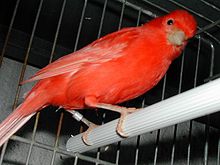Red factor canary

The red factor canary[1] is a variety of domestic canary, named after its colorful plumage. It is a bird commonly kept as a pet and for showing.
Description
[edit]The red factor canary averages about 5+1⁄2 inches (14 cm) in length. This variety of canary tends to be bred for the novelty of its color, rather than for its song.
It was developed as a cross between another type of finch — the now-endangered Venezuelan red siskin (Spinus cucullatus) — and a yellow domestic canary (Serinus canaria domestica). [2][3]
In breeding/showing, domestic canaries are broken down into two types based on pigmentation: melanics[4] and lipochromes.[5] Melanics contain melanin markings over top of lipochromes in their feathers, while lipochrome canaries have feathers that contain no melanin in their pigmentation. The red factor canary is classified as a lipochrome.
There are two types of red factor canaries based on the lipochrome distribution in their plumage: intensive red factors and non-intensive red factors. Intensive red factors are characterized by even lipochrome distribution throughout their feathers, giving the plumage a bright and uniform appearance throughout. Birds with non-intensive coloration have feathers that lack pigmentation at the tips — referred to as frosting due to the appearance — this makes for a more subdued brightness in appearance than birds with intensive coloration.
Availability
[edit]Red factor canaries are usually available at most pet stores and can also be found through bird shows, bird clubs, breeders and on the internet.
See also
[edit]- Atlantic canary (wild canary)
- Australian plainhead
- Harz Roller
References
[edit]- ^ "The Red Factor Canary". www.canaryadvisor.com. Archived from the original on 2008-08-18. Retrieved 2008-08-11.
- ^ Goldman, Steve (February 15, 2004). "A brand-new bird: how two amateur scientists created the first genetically engineered animal". The Journal of Clinical Investigation. 113 (4): 495–495. doi:10.1172/JCI21127. PMC 338274. Archived from the original on June 15, 2024. Retrieved June 28, 2024 – via www.jci.org.
- ^ canariasacross (2023-12-06). "Discover the Fascinating World of Domestic Canaries and Their Unique Characteristics". Canary Islands, Spain. Retrieved 2024-10-03.
- ^ Culture, Canary (2023-11-30). "Understanding Classic Melanic Canaries". Canary Culture. Retrieved 2024-10-03.
- ^ Culture, Canary (2023-10-18). "Understanding Lipochrome Canaries". Canary Culture. Retrieved 2024-10-03.
